
Goodwin Sands is a 10-mile-long (16 km) sandbank at the southern end of the North Sea lying 6 miles (10 km) off the Deal coast in Kent, England. The area consists of a layer of approximately 25 m (82 ft) depth of fine sand resting on an Upper Chalk platform belonging to the same geological feature that incorporates the White Cliffs of Dover. The banks lie between 0.5 m above the low water mark to around 3 m (10 ft) below low water, except for one channel that drops to around 20 m (66 ft) below. Tides and currents are constantly shifting the shoals.
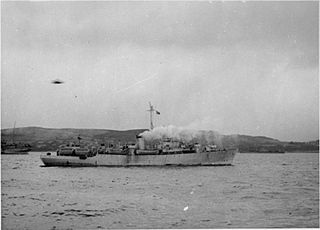
SS Empire Rest was a convoy rescue ship built for the Royal Navy during World War II, originally laid down as the Castle-class corvette Rayleigh Castle. Post-war she served as a transport ship until 1948, was sold in 1951, and scrapped in 1952.

HMS Wild Swan was an Admiralty modified W-class destroyer built for the Royal Navy. She was one of four destroyers ordered in 1918 from Swan Hunter and Wigham Richardson, Wallsend-on-Tyne under the 14th Order for Destroyers of the Emergency War Program of 1917–18. She was the second Royal Navy ship to carry the name, after the sloop HMS Wild Swan in 1876. Like her sisters, she was completed too late to see action in the First World War.

SS Empire Simba was a British steam-powered cargo ship. She was originally an American ship, launched in 1918 as SS West Cohas. During a stint in the United States Navy from 1918 to 1919, she was called USS West Cohas (ID-3253).
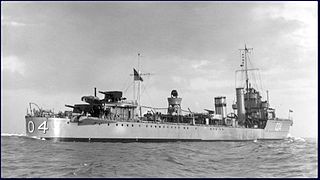
HMS Vancouver was a British V-class destroyer. She was launched on 28 December 1917; in July 1922 she accidentally rammed the submarine H24. She was renamed HMS Vimy in April 1928. She served with distinction during World War II, earning two battle honours and damaging or sinking three enemy submarines. The Royal Navy retired her in 1945 and she was scrapped in 1948.

SS Mahratta was a steamship owned by Brocklebank Line which was launched in 1891 and ran aground on the Goodwin Sands in 1909.
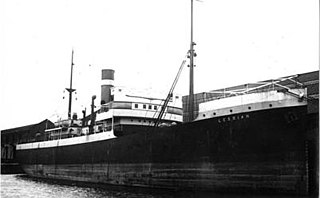
Lesbian was a 2,352 GRT cargo ship which was built by Swan, Hunter and Wigham Richardson Ltd, Newcastle upon Tyne in 1923 for Ellerman Lines Ltd. She was seized in 1940 by the Vichy French forces.
Sylvan Arrow was a steam tanker built in 1917–1918 by New York Shipbuilding Co. of Camden for Standard Oil Company, with intention of transporting oil and petroleum products between United States and ports in the Far East. The ship was briefly requisitioned by the US Government during World War I but returned to commercial service in early 1919.

SS West Eldara was a steel-hulled cargo ship built in 1918 as part of the United States Shipping Board's emergency World War I shipbuilding program.
Over the years, a number of ships have foundered off Southport. For the purposes of this article, the Southport area shall be considered as Southwards from Lytham St Annes to Freshfield.
Gripfast was a 2,852 GRT coaster which was built in 1941 as Empire Brook for the Ministry of War Transport (MoWT). She was sold into civil service in 1946 and renamed Stancliffe. She ran aground in 1948 and was declared a constructive total loss, having broken her back. Despite this, she was repaired and saw further service as Gripfast, Capetan Costas P, Karine M and Pitsa before sinking when under tow on 6 December 1967.
Empire Buckler was a 7,046 GRT cargo ship which was built in 1941 by Lithgows Ltd for the Ministry of War Transport (MoWT). Postwar she was sold into merchant service, being renamed Ovingdean Grange, Sabrina, and Noemi, serving until she ran aground in 1965 and was declared a constructive total loss.
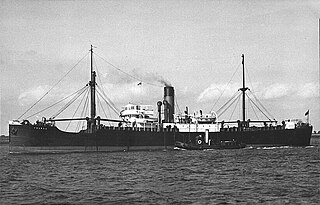
SS Thurso was a cargo steamship operated by Ellerman's Wilson Line. Thurso was built in 1919 by S. P. Austin & Sons in Sunderland as the War Bramble for the Shipping Controller. Measuring 2,436 gross register tons, the ship had a speed of 9 knots. She was sold to Ellerman Lines while still under construction and remained with the company until lost during the Second World War.

Acushnet – a steel-hulled revenue cutter – was launched on 16 May 1908 at Newport News, Virginia, by the Newport News Shipbuilding and Drydock Co.; sponsored by Miss Alayce Duff; and commissioned at Baltimore on 6 November 1908. She saw service as a United States Revenue Cutter Service cutter, a U.S. Navy fleet tug, and as a U.S. Coast Guard cutter. She was taken out of service 8 January 1946.

HMS Wishart (D67) was a Modified W-class destroyer of the British Royal Navy that saw service in World War II. She spent most of her wartime career based at Gibraltar, engaged in convoy defence, but also served in various naval and military operations in the Mediterranean Sea.
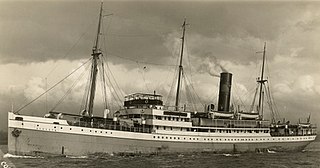
SS Avoceta was a British steam passenger liner. She was built in Dundee in 1923 and was sunk by enemy action in the North Atlantic in 1941. She belonged to Yeoward Line, which carried passengers and fruit between Liverpool, Lisbon, Madeira and the Canary Islands.
SS Mohamed Ali El-Kebir, formerly SS Teno, was one of a pair of steam turbine ocean liners built in Scotland in 1922 for the Chilean company CSAV. She and her sister ship Aconcagua ran between Valparaíso and New York via the Panama Canal until 1932, when CSAV was hit by the Great Depression and surrendered the two ships to the Scottish shipbuilder Lithgows to clear a debt.
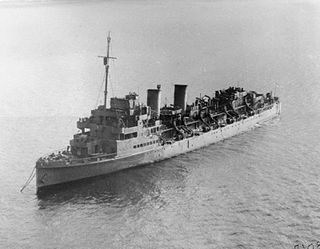
SS Prinses Astrid was a Belgian cross-Channel ferry struck a naval mine 3 nautical miles (5.6 km) off the coast of Dunkirk, France and sank with the loss of five of her 65 crew. All 60 survivors and 218 passengers on board were rescued by SS Cap Hatid (France) and various tugs from Dunkirk.

The SS Luray Victory was the seventeenth Victory ship, a new 10,500 ton class ship built during World War II. The California Shipbuilding Company built the ship under the Emergency Shipbuilding program. She was launched on May 11, 1944, and completed on June 26, 1944. The ship’s United States Maritime Commission designation was VC2-S-AP3, hull number 17 (V-17). The SS Luray Victory served in the Pacific Ocean during World War II and was operated by the Black Diamond Steamship Company.














